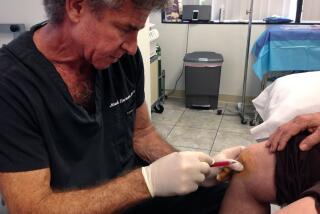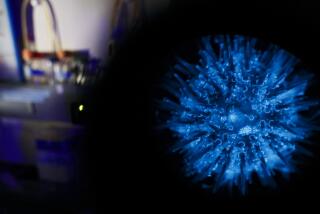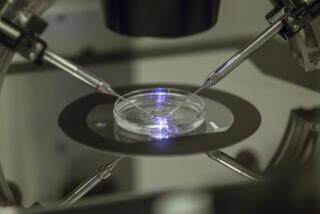Science can’t escape debate
WASHINGTON — The political controversy over restrictions on federal funding for embryonic stem cell research is unlikely to end with Tuesday’s news that mature human cells can be made to acquire the powers of embryonic stem cells, because scientists say research on both types of cells is closely related and is needed to inspire and cross-check each other.
President Bush has twice vetoed legislation that would lift restrictions on federal funding for embryonic stem cell research, and Congress has not mustered the two-thirds majority in each chamber required to override presidential opposition.
The scientific breakthrough that makes mature cells act like embryonic cells will allow the Bush administration to approve funding for a promising new line of research, but backers of embryonic research said that the older approach was too far along to abandon.
“I must say, this is a very exciting breakthrough, and it shows great promise, but it’s still in its very early stages,” said Rep. Diana DeGette (D-Colo.), a leading supporter of loosening federal restrictions on human embryonic research. “People like me feel we have to encourage all forms of the research, because you never know where the cure is going to come from.”
Amy Comstock Rick, chief executive of the Parkinson’s Action Network, said research on embryonic stem cells was much more advanced. “Unless something has been shown to fail, it should not be taken off the table, and embryonic stem cell research has shown great promise,” she said.
The two kinds of scientific research will probably move in tandem for some time.
“I think we will see parallel science until we get a sense of whether the new alternative really is an alternative,” said medical ethicist Arthur Caplan of the University of Pennsylvania. “If it proves to be real, I think you will see a diminishment of interest in human embryonic research.”
In theory, stem cells can be grown into any type of cell in the body, so they are seen as holding the key to a new era of regenerative medicine. Some scientists believe their use could eventually result in cures for Parkinson’s disease and other intractable illnesses. Many have thought that cells taken from human embryos hold the greatest promise, but scientists have now shown that skin cells and fibroblasts can be manipulated to acquire the same kinds of transformative powers possessed by stem cells.
The White House hailed the latest scientific breakthrough as vindication of Bush’s steadfast refusal to fund research that would result in the destruction of human embryos.
“What seems to be happening is that science is overtaking politics and making a lot of political arguments irrelevant,” said Karl Zinsmeister, a senior White House advisor. “The president always felt there was more than one way to solve the stem cell problem.”
Seeking a compromise, Bush in 2001 limited federal funding for embryonic research to existing cell lines. About 20 of those lines are still around, but some scientists say the lines have become genetically degraded and are ill-suited for research. This summer, Bush signed an order directing the National Institutes of Health to look for promising alternatives to embryonic research and specifically singled out the work on skin cells.
Religious conservatives say the promising research on mature human cells will make it easier for lawmakers to back away from supporting work that involves human embryos.
“They can go ahead and have stem cells, but they don’t need to go the destructive path; this is easier and can get [federal] funding, and they don’t have to worry about the ethical baggage,” said David Prentice, science advisor for the conservative Family Research Council.
But the head of the National Institutes of Health stem cell task force said it would be a mistake for scientists to back away from research on embryonic cells. Dr. Story Landis said the breakthrough with mature cells was possible in part because of earlier work with embryonic cells. “This does not obviate the need for human embryonic stem cell research,” Landis said.
To be able to compare results from the two types of research “is critical,” she added.
ricardo.alonso-zaldivar@
latimes.com
--
(BEGIN TEXT OF INFOBOX)
Timeline
Key dates in embryonic stem cell research:
1981: Martin Evans of University of Cambridge, England, and Gail Martin of UC San Francisco separately isolate embryonic stem cells in mice for the first time.
1994: President Clinton bans the use of federal money to create human embryos solely for research purposes, while permitting research on embryos left over from in vitro fertility treatments.
1996: Congress bans federal funding for research in which embryos are destroyed.
1998: Researchers at the University of Wisconsin isolate and grow human embryonic stem cells, prompting patient advocates to urge Congress to lift its ban on federal funding for embryo research.
2000: The National Institutes of Health invites scientists to apply for the first federal grants for research using embryonic stem cells, touching off a debate between anti-abortion groups and patients with diabetes, heart disease and other ailments.
July 2001: Pope John Paul II tells President George W. Bush that the use of human embryos for medical research is an “evil” akin to abortion and infanticide.
August 2001: Bush issues an executive order restricting federal funding for embryonic stem cell research to cell lines already in existence.
February 2004: South Korean scientist Hwang Woo-suk publishes a study in Science claiming to have created stem cells from cloned human embryos, paving the way for cell lines genetically matched to individual patients. A second blockbuster study follows the next year.
November 2004: California voters approve a $3-billion bond measure to fund stem cell research.
2005: Hwang Woo-suk is accused of fabricating data in his landmark stem cell studies. He later faces charges of fraud and misuse of research funds.
2006: Bush vetoes a bill that would have expanded federal support for embryonic stem cell research.
March 2007: Dr. Elias A. Zerhouni, director of the National Institutes of Health, tells Congress that he backs an end to restrictions on federal funding for embryonic stem cell research.
Tuesday: Scientists report that human skin cells can be reprogrammed to behave almost exactly like embryonic stem cells.
Source: Times research by Scott J. Wilson






